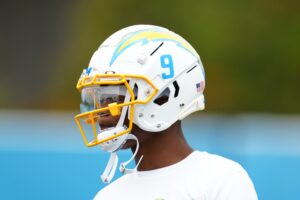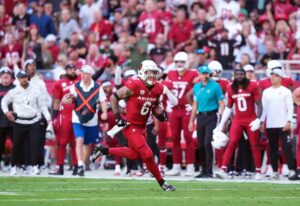New York Jets 2016 Draft Class Making Strides in Second Year
The New York Jets are rebuilding. They made that abundantly clear this offseason, cutting veteran after veteran and infusing the roster with young, unproven players. At the forefront of this self-titled youth movement is the team’s 2016 draft class. A class that, after just one season, seemed to be destined for disappointment. Darron Lee struggled. Lachlan Edwards was among the league’s worst punters. Jordan Jenkins had a solid rookie campaign, but didn’t seem to be a difference-maker at the edge position. Perhaps the only gem of the class appeared to be Robby Anderson, an undrafted wide receiver with a knack for getting behind the defense. Now, just a year later, the class is trending in the opposite direction. Aside from the Christian Hackenberg dilemma, each of the aforementioned players–and a few others–appear to be important pieces of the team going forward, as the Jets look to claw their way back to the top of the league’s food chain.
Analysis of any draft class begins with its first round pick. Darron Lee was selected twentieth overall, and expectations were high right off the bat. He was the team’s stater from the minute he was drafted, and it showed. Lee took his rookie lumps, and then some, particularly as the season wore on. He’s small for an NFL linebacker, and was often swallowed up at the line by his much larger offensive counterparts. He had struggles in pass coverage. It’s not like Lee was a disaster–his seventy three tackles were second on the team to only David Harris. But still, there was some cause for concern as Lee approached year two. Through the first six games of 2017, such concern appeared to be justified. The same issues that had plagued Lee in 2016 appeared once again, and Pro Football Focus ranked him as the league’s very worst linebacker. Yet for whatever reason, in week seven, things started coming together for the Ohio State product. He started to utilize the speed that made him a first round draft pick, flashing to the ball on a routine basis. He followed up a strong effort against the Dolphins with a nice outing against the Falcons, and a dominant display against the Bills in which he was all over the field. His PFF grades measured 78.5, 81.2, and 86.0 over that three game stretch good for fifth among all linebackers in that span. Obviously, Lee needs to maintain that level of play for more than just a three game stretch. But the Jets have to pleased at the strides Lee has made, emerging as a core piece of an exciting young defense.
General manager Mike Maccagnan remains a polarizing figure among Jets fans, and will likely remain so until he finds–or fails to find–that ever-elusive franchise quarterback. But the Jets’ GM has excelled at one particular aspect at his job, above all else. He’s done a phenomenal job of getting fantastic value out of low-risk, high-reward decisions. In 2015, he brought in Brandon Marshall and Ryan Fitzpatrick in for virtually nothing, forming the nucleus of a 10-6 team. Prior to the 2017 season, Maccagnan traded Calvin Pryor for Demario Davis. The deal went relatively unnoticed at the time, but it has proved to be among the most important decisions he made all offseason. And in the 2016 draft, he only had to spend a seventh-round pick and an undrafted selection to bring both Lachlan Edwards and Robby Anderson to the Jets.
Edwards has been the most improved Jet this season. And it’s not close. After a rookie campaign in which he struggled mightily, Edwards has been among the league’s best punters in 2017. His 21 punts inside the opponents’ 20 yard line is the third most in the league, and his average of 47.4 yards per punt rank tenth overall. The Jets have found their punter of the future. If only finding a quarterback was that easy.
Last of all, the Jets’ last acquisition in the 2016 draft may have also been their best. Robby Anderson arrived at One Jets Drive as an undrafted rookie with long-shot odds at even making the roster. Exactly nineteen months later, he’s not just on the roster, but a crucial part of it. Anderson has thirty-five catches for 568 yards and five scores in ten games this season. Look for those stats to only improve over the final six games of the year, as he and teammate Josh McCown have seemed to find the chemistry that had previously been lacking in the early stages of the season. Anderson had a surprisingly good rookie season, but he did so as a one-dimensional vertical threat. In 2017, Anderson has fine-tuned his game, adding a reliable slant route to his arsenal. Obviously, the key is consistency, especially with a player like Anderson. But it appears as if the Jets have a franchise receiver on their hands to couple with Quincy Enunwa. If Anderson and Enunwa play like true stars–which they’ve shown they can be–and the Jets resign Austin Seferian-Jenkins, the team is only one piece away from an outstanding group of pass-catchers.
And so, although the Jets are 4-6 and remain a long-shot for the postseason, the tone surrounding the team should be one of optimism. Mike Maccagnan’s 2016 draft class is producing. Jamal Adams and Marcus Maye appear to be the team’s future at safety for years to come. Obviously, the missing piece of the puzzle is the quarterback position. Yet if the team can finally get their hands on an elite gunslinger–something they haven’t been able to do since Joe Namath was lighting up Broadway–they’ll be a championship contender for the first time since 2010.
Main Photo:
Embed from Getty Images






